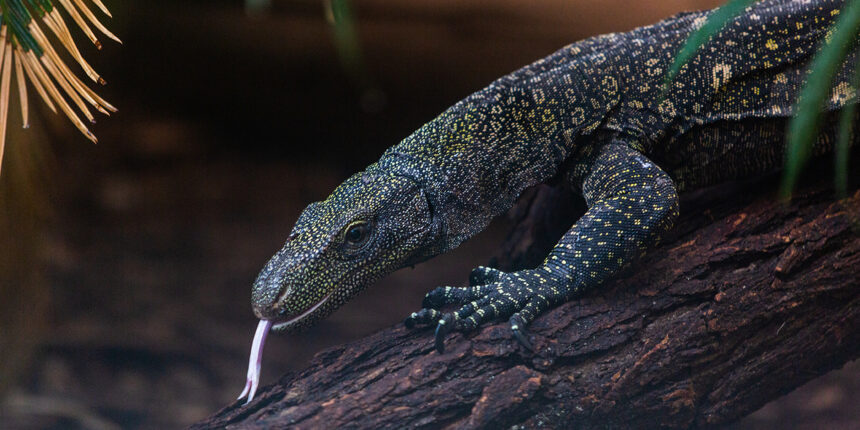Introduction to the Crocodile Monitor
The crocodile monitor is a remarkable creature that captures the imagination of wildlife enthusiasts and casual observers alike.
With its striking appearance and impressive size, this unique lizard stands out in the diverse world of reptiles.
Native to New Guinea and surrounding islands, it boasts an intriguing mix of adaptability and specialized needs that shape its existence in the wild.
As we delve into what makes the crocodile monitor so fascinating, we’ll explore its physical characteristics, habitat requirements, distribution patterns, threats from human activity, conservation efforts underway to protect them, and even tips for encountering these magnificent creatures in their natural environment.
Whether you’re a seasoned herpetologist or just curious about one of nature’s most captivating lizards, join us on this journey into the life of the crocodile monitor!
Physical Characteristics and Habitat Requirements
The crocodile monitor, known scientifically as Varanus salvadorii, is a striking reptile. It can grow up to 10 feet long, making it one of the largest lizards in the world. Its elongated body is covered with dark green and black scales that provide excellent camouflage among the dense foliage.
These monitors are arboreal creatures, thriving in tropical rainforests. They require a humid environment with ample tree cover to navigate their surroundings easily. Their strong limbs and sharp claws allow them to climb efficiently, seeking out nests or perching high above ground.
Crocodile monitors also need access to water sources for hydration and hunting purposes. They often dwell near rivers or streams where they can find food like birds and small mammals. The right habitat ensures their survival and supports their unique lifestyle as both climbers and swimmers.
The Natural Habitat of the Crocodile Monitor
The crocodile monitor thrives in lush tropical environments. Native to New Guinea and surrounding islands, these reptiles are often found in rainforests, swamps, and mangrove ecosystems.
They prefer areas with abundant trees. These towering giants provide essential cover and nesting sites. The dense foliage offers a perfect hunting ground for their prey.
Crocodile monitors are adept climbers. Their long bodies allow them to navigate branches with ease. This arboreal lifestyle is crucial for their survival.
Water sources play a vital role too. They can frequently be spotted near rivers or freshwater streams, where they hunt small mammals, birds, and insects.
High humidity levels complement their habitat requirements perfectly. This environment supports the moisture-loving creatures that share their ecosystem.
Distribution and Population of Crocodile Monitors
Crocodile monitors, or Varanus salvator, primarily inhabit the rainforests and mangrove swamps of New Guinea and surrounding islands. They thrive in humid environments where they can easily find food and shelter.
Their distribution is closely linked to the availability of trees. These reptiles are excellent climbers and often reside in tall trees. This arboreal lifestyle allows them to hunt for birds, eggs, and small mammals effectively.
Population numbers fluctuate due to habitat changes. While exact figures remain elusive, some areas indicate stable populations thanks to protected environments. However, human encroachment poses significant risks.
Local communities play a crucial role in conservation efforts by recognizing the importance of these creatures within their ecosystems. Understanding their distribution not only enhances awareness but also promotes actions aimed at protecting their habitats for future generations.
Threats to their Natural Habitat
The natural habitat of the crocodile monitor is increasingly threatened by human activities. Deforestation poses a significant risk, as vast areas of rainforest are cleared for agriculture and urban development. This loss disrupts their ecosystems and food sources.
Additionally, illegal hunting contributes to their population decline. These stunning reptiles are often targeted for their skins or captured for the exotic pet trade. Such practices not only reduce numbers but also disturb local populations.
Climate change further exacerbates these challenges. Altered weather patterns affect rainfall and temperature, impacting both flora and fauna in their habitats. Rising sea levels threaten low-lying areas where some crocodile monitors reside.
Every threat compounds the others, creating a precarious situation for this unique species. Conserving their environment requires immediate action from governments and communities alike to ensure that these remarkable lizards continue to thrive in the wild.
Conservation Efforts
Conservation efforts for the crocodile monitor are crucial in preserving this remarkable species. Organizations and governments are taking steps to ensure their survival amid habitat loss and poaching.
Protected areas have been established, allowing these reptiles to thrive in their natural environment. These reserves help maintain a balanced ecosystem, promoting biodiversity alongside the crocodile monitor.
Education programs play a vital role as well. They aim to raise awareness among local communities about the importance of protecting these lizards. By informing people about their ecological significance, conservationists encourage sustainable practices that benefit both wildlife and humans.
Research initiatives also contribute significantly. Scientists study their behavior, habitat needs, and population dynamics to develop effective management strategies. This data is invaluable for crafting policies aimed at safeguarding the future of crocodile monitors in the wild.
Tips for Observing Crocodile Monitors in their Natural Habitat
Observing crocodile monitors in their natural habitat can be a thrilling experience. To enhance your chances, start by researching locations where they are commonly found, such as the rainforests of New Guinea.
Visit during early morning or late afternoon when these reptiles are most active. Bring binoculars for a close-up view without disturbing them.
Approach quietly and avoid sudden movements to keep from scaring them away. Patience is key; spend time in one spot and let the wildlife come to you.
Stay aware of your surroundings. Crocodile monitors may be camouflaged among trees or foliage, so look carefully.
Consider joining guided tours led by local experts who know the best areas to explore while ensuring minimal impact on their environment. This not only increases your chances but also helps support conservation efforts directly linked to these remarkable creatures.
Conclusion
The crocodile monitor is a fascinating creature that embodies the rich biodiversity of its native habitat. Understanding their physical characteristics helps us appreciate how they thrive in tropical forests and humid environments. Their natural habitats are lush, often found in lowland rainforests or near riverbanks.
These magnificent reptiles play an important role in their ecosystems, yet they face threats from deforestation and human encroachment. Conservation efforts aim to protect these unique lizards by preserving their natural habitats and promoting awareness about their ecological significance.
For those keen on observing crocodile monitors in the wild, patience is essential. They can be elusive but are often spotted basking on branches or hunting for prey if one knows where to look.
Crocodile monitors truly deserve our attention as we continue to explore ways to safeguard them and their environments for future generations. The intricate balance of nature relies on understanding creatures like this reptile, ensuring both coexistence and appreciation of wildlife diversity.





